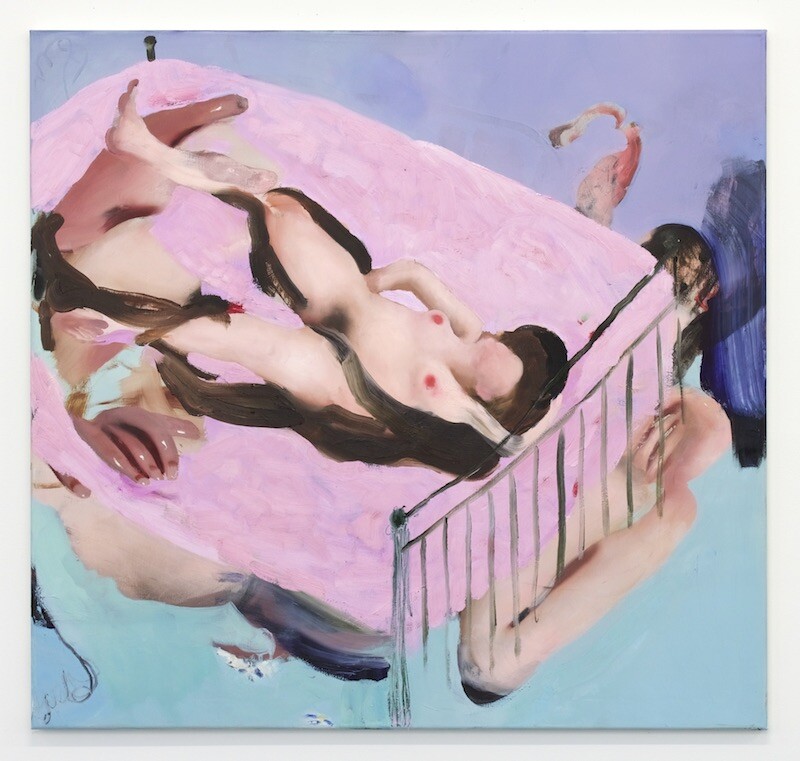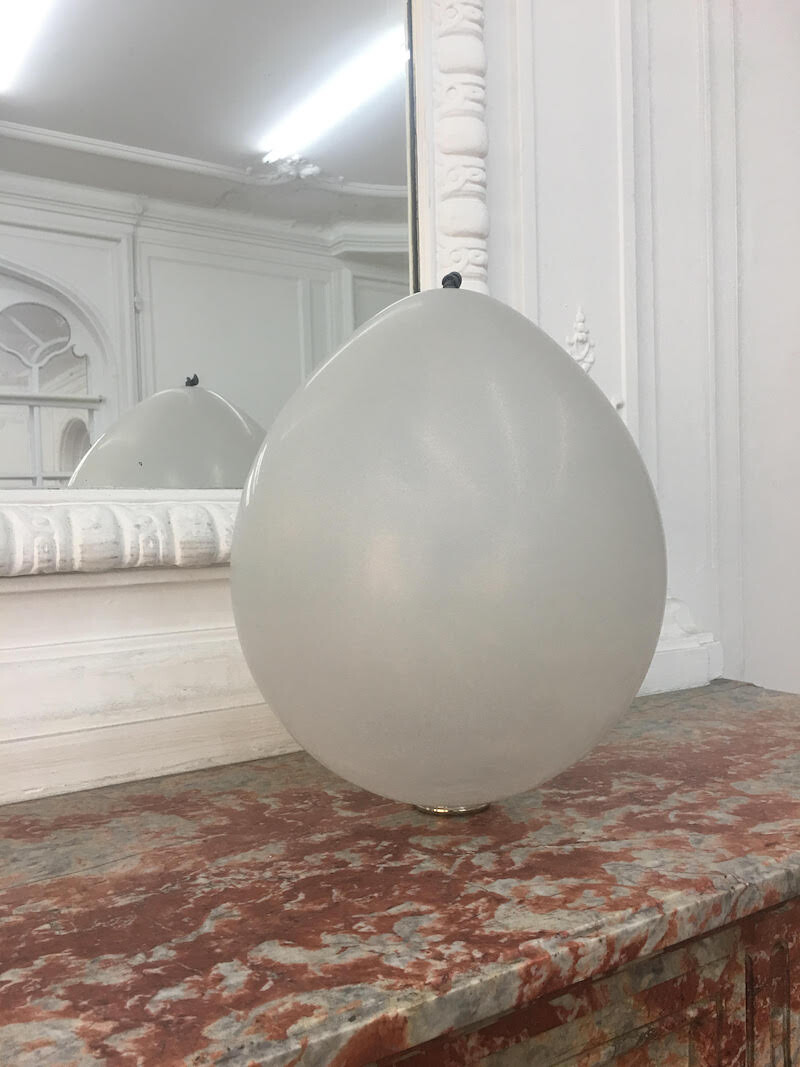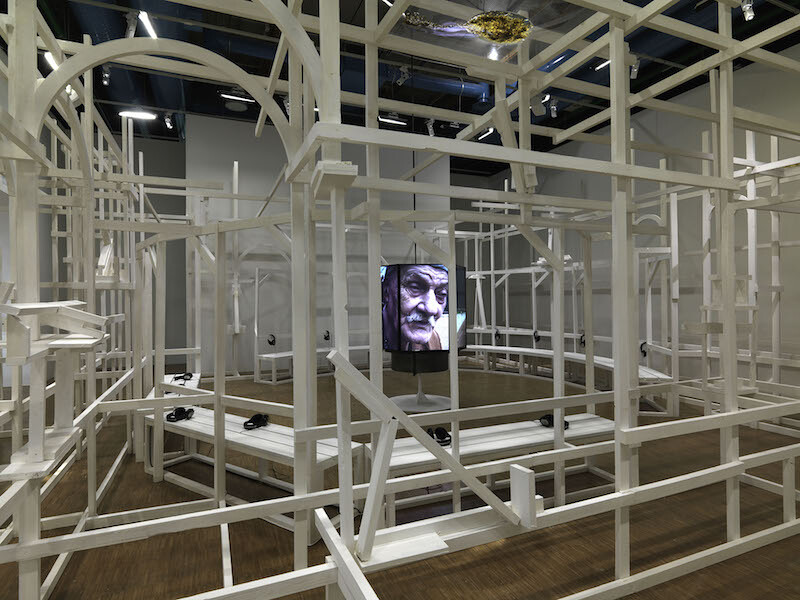Stamina This is by no means comprehensive, so I’ll get my highlights out of the way. Rounding down, and starting with the experiential: I found the hunt for the various venues of Avant-Première compelling. This casually organized event was comprised of small Parisian galleries and emerging ventures opening their shows a few days before the fairs and driving traffic from post-Frieze London. Out-of-towners (this year, Los Angeles galleries) were embedded in unconventional spaces: up spiraling staircases and behind doorbell-laden portals. At the Beaux Arts, Nairy Baghramian’s exhibition of self-reflexive, materially seductive sculptures—in which shims and buffers, made of aluminum and cork, held up large unwieldy shapes—defied definitions of form; at Balice Hertling’s Marais space, Isabelle Cornaro’s detail-oriented objects and careful placement evoked stilled narratives; small captivating pictures by Lisetta Carmi hung quietly in Galerie Antoine Levi, capturing tender backstage scenes between sex-workers, trans lovers, and friends. A night, at the legendary club Les Bains Douches, where the smell of chlorine and the reflection of the indoor pool added to the intemperance of its crowd; a day prior, at a small hotel lounge, when our bartender told us that Oscar Wilde died just over there, a few feet away from our wine; After 8 Books’s content and its narrow passageway home. At FIAC, Ambera Wellmann’s lush, subject-bending paintings, embodying figures in motion with otherworldly physics, showcased by Mexico City’s Lulu on a marginal wall of the fair (interrupted by an emergency exit door, or perhaps a janitorial closet) was nonetheless a showstopper; Alexandru Chiru’s dreamy UFO paintings at Delmes & Zander, Cologne, as well. Across town, in a derelict hôtel particulier, Paris Internationale’s exhibitors hung works in colorfully tiled bathrooms, in ornately molded hallways, and teetering on the edge of decorative fireplaces (like Silver Balloon, 2018, Michael Queenland’s permanently inflated, precarious-seeming sculpture in Los Angeles gallery Kristina Kite’s light-filled corner); Soshiro Matsubara’s delicate pink painting depicting two figures touching tongues at Tokyo’s XYZ Collective (Kiss VII, 2018); an exquisitely disorienting new video, A fire circle for a public hearing (2018) by Paul Maheke, exhibited by Sultana, Paris, caught my eye too. On a large flat screen leaning on a wall, the artist spun and spun—a captured performance that evokes a striking new generation of dancers incredibly adept at making video of their choreography, sophisticatedly using the proscenium of the frame as well as the position of the camera/viewer (a selfie-stick-like vantage point) to address far larger themes of contemporary viewership. And finally, Sophie Jung’s beguiling performance Paramount VS Tantamount (2018) at the Centre Culturel Suisse in the Marais, mesmerizing viewers through her skilled delivery of a rapid-fire hour-long monologue. These comprise the shortlist of my highlights.
In the long list, I would add Franz West’s retrospective at the Centre Pompidou, a compact exhibition encapsulating the artist’s thoughtful oeuvre, collaborations, experiments, and humor, as it archives his ideological dilettantism; the artist, an autodidact of his craft, lauded intellectual dérive and held in high praise the simple act of lying down. The show is energized by its light-heartedness and intimacy. It was like entering a contagiously prolific mind or workspace. Similarly, at Kamel Mennour, Tatiana Trouvé’s “A Quiet Life” embodies, I was told, the artist at work in the studio—inspired by Bruce Nauman’s recording of his own workspace—though hers is made of marble, steel, and glass, a presentation adamantly less casual than her two male counterparts. In one of her sculptures, two steel shoes (hers perhaps) lay brutally crushed by a pane of glass.
Commerce The mise en abyme of businesses in Avant-Première seemed significant. Art was exhibited in restaurants, flower shops, consultant’s offices; that, conflated with the various enterprise-funded foundations—Galeries Lafayette, Louis Vuitton, Ricard—and their namesake spaces, raised questions around the merging of commodities and the venues through which art is distributed to viewers, and how that might inflect their viewing. Commerce—big and small, product and consumption—factored largely into the energy of the week, a hybrid that could also be sensed in the artworks themselves. At Paris Internationale, 650mAh, a young exhibitor from Hove, UK, filled a closet space with arresting works by Tenant of Culture, a moniker for a young artist whose garment-like sculptures cannibalize functional wearables into hanging harness-like pieces; Simon Fujiwara’s The Happy Museum (2018), as part of “Revolution,” his solo exhibition at Lafayette Anticipation, showcases various carefully selected consumer goods in vitrines.
Revolution From vantage point of the Petit Palais, across the street from the Grand Palais—in an airy show of FIAC Projects curated by Marc-Olivier Wahler—I thought about revolution. On my way home, in the far exit of the Jardin des Tuileries, where the FIAC Hors les Murs was staged, the thought echoed again as I passed Alicja Kwade’s aerodynamic sculpture Revolution (Gravitas) (2018), a work whose physics flexed the double entendre of the term. I reconsidered Simon Fujiwara’s aforementioned show at Lafayette, “Revolution.” It opens with Empathy I (2018) a work for which the artist collaborated with rollercoaster engineers. Viewers, strapped in and asked to hold onto handles, are shaken, quite literally, into the embodied experience of being bombarded by disparate images, a corollary to how social media platforms indiscriminatingly feed us an array of content. (It was that, or what it feels like to be a phone—which is weird, and perhaps funnier.) The ride shook, blew air, water even. Its point of view shifted constantly. It was only four minutes long, but when it ended I felt relieved and genuinely uncertain that it needed to be quite so literal about its argument. Unnerved by the grandiosity of the exhibition’s title and the conflation of various contemporary cultural phenomena—from self-fashioning to advertising—upon the four floors of the new building, I spent the rest of the week walking it off. I thought that art too often becomes the illustration of revolution—rather than revolution itself.
That said, a few blocks away at the Pompidou, Mohamed Bourouissa’s Pas le temps pour les regrets [No time to regret] (2018) broadcast the voice of radical thinker Frantz Fanon over an elaborate scaffolding (reminiscent of Noah Purifoy’s rogue desert museum in the Californian Mojave) and a sculpturally installed video. The work, Bourouissa’s presentation for the Prix Marcel Duchamp, is a first-person account by a patient, describing the innovative garden-building project, inspired by Fanon’s philosophy, set in the Blida-Joinville Hospital in Algeria, the country’s first psychiatric institute. The connection to the land, the empowering of the marginalized, and the decolonization of the medical practices rang a different tenor, a sense of faith in the ability of institutions to mediate change. It also spoke, through its sheer presence, to the urgent question of who can now inhabit, even run, institutions.
Around the corner from Bourouissa’s installation, Clément Cogitore (the Prix Marcel Duchamp winner) presents The Evil Eye (2018) a post-apocalyptic video constructed from borrowed promotional images. The video is populated exclusively by female characters, alternating between young and aged, represented mostly via the high-definition lens of an advertising aesthetic. Coolly narrated, sometimes subtitled for emphasis, the video draws a picture of a world post-disaster that felt familiar, tenable. “They did what they could,” the voice promised, about the pre-fallout inhabitants who could have prevented it.












